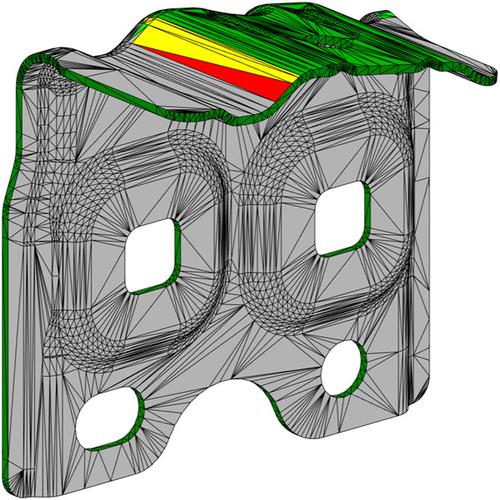当前位置:
X-MOL 学术
›
Mater. Corros.
›
论文详情
Our official English website, www.x-mol.net, welcomes your
feedback! (Note: you will need to create a separate account there.)
Semantic segmentation of corrosive critical designs in body‐in‐white structures for corrosion simulation
Materials and Corrosion ( IF 1.6 ) Pub Date : 2020-12-21 , DOI: 10.1002/maco.202012134 Ludwig Waibel 1 , Andreas Mittelbach 1 , Stefan Funken 2
Materials and Corrosion ( IF 1.6 ) Pub Date : 2020-12-21 , DOI: 10.1002/maco.202012134 Ludwig Waibel 1 , Andreas Mittelbach 1 , Stefan Funken 2
Affiliation

|
Scaling finite element method (FEM) based corrosion simulations to whole body‐in‐white structures lead to extremely high computational costs. As corrosion only appears in corrosive critical areas, the FEM is restricted to these. The objective is a semantic segmentation of corrosive critical designs, which are part edges and flanges in body‐in‐white structures. Different deterministic as well as Machine Learning and Deep Learning approaches are proposed and compared with respect to their ability to segment critical designs based on the geometry and the spatial relations of the parts only. The deterministic edge detection provides a fast and highly accurate way to segment part edges, whereas the described deterministic flange detection is not suitable for capturing the full diversity of flange structures. As the feature‐based Machine Learning approach evaluates more properties in a more flexible way, the performance of the flange detection is significantly increased and even the edge segmentation obtains slightly better results. The evaluation of graph structures with a Geometric Deep Learning method fails as the train set is too small to sufficiently represent the complex and various structures in the test set.
中文翻译:

白车身结构中腐蚀关键设计的语义分割,用于腐蚀模拟
基于缩放有限元方法(FEM)的白车身整体腐蚀模拟导致极高的计算成本。由于腐蚀仅出现在腐蚀性的关键区域,因此FEM仅限于这些区域。目的是对腐蚀性关键设计进行语义分割,这些关键设计是白车身结构中的零件边缘和法兰。提出了不同的确定性以及机器学习和深度学习方法,并就它们仅根据零件的几何形状和空间关系对关键设计进行细分的能力进行了比较。确定性边缘检测提供了一种快速且高度准确的方式来分割零件边缘,而所描述的确定性法兰检测不适用于捕获法兰结构的全部多样性。随着基于特征的机器学习方法以更灵活的方式评估更多属性,法兰检测的性能得到显着提高,甚至边缘分割也获得了更好的结果。由于训练集太小而无法充分代表测试集中的复杂和各种结构,因此无法使用几何深度学习方法对图形结构进行评估。
更新日期:2020-12-21
中文翻译:

白车身结构中腐蚀关键设计的语义分割,用于腐蚀模拟
基于缩放有限元方法(FEM)的白车身整体腐蚀模拟导致极高的计算成本。由于腐蚀仅出现在腐蚀性的关键区域,因此FEM仅限于这些区域。目的是对腐蚀性关键设计进行语义分割,这些关键设计是白车身结构中的零件边缘和法兰。提出了不同的确定性以及机器学习和深度学习方法,并就它们仅根据零件的几何形状和空间关系对关键设计进行细分的能力进行了比较。确定性边缘检测提供了一种快速且高度准确的方式来分割零件边缘,而所描述的确定性法兰检测不适用于捕获法兰结构的全部多样性。随着基于特征的机器学习方法以更灵活的方式评估更多属性,法兰检测的性能得到显着提高,甚至边缘分割也获得了更好的结果。由于训练集太小而无法充分代表测试集中的复杂和各种结构,因此无法使用几何深度学习方法对图形结构进行评估。











































 京公网安备 11010802027423号
京公网安备 11010802027423号